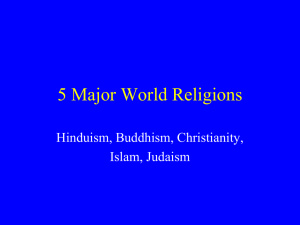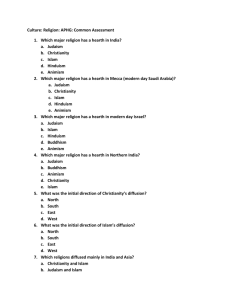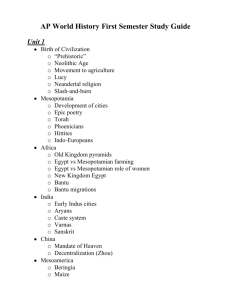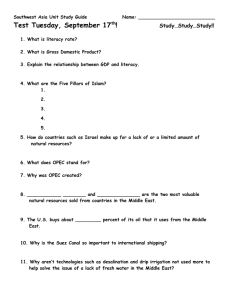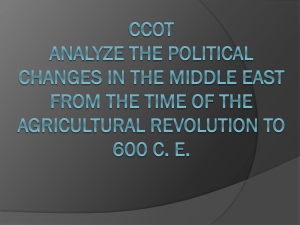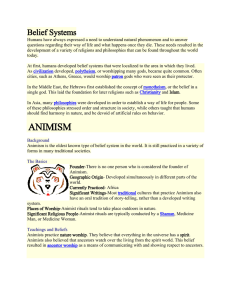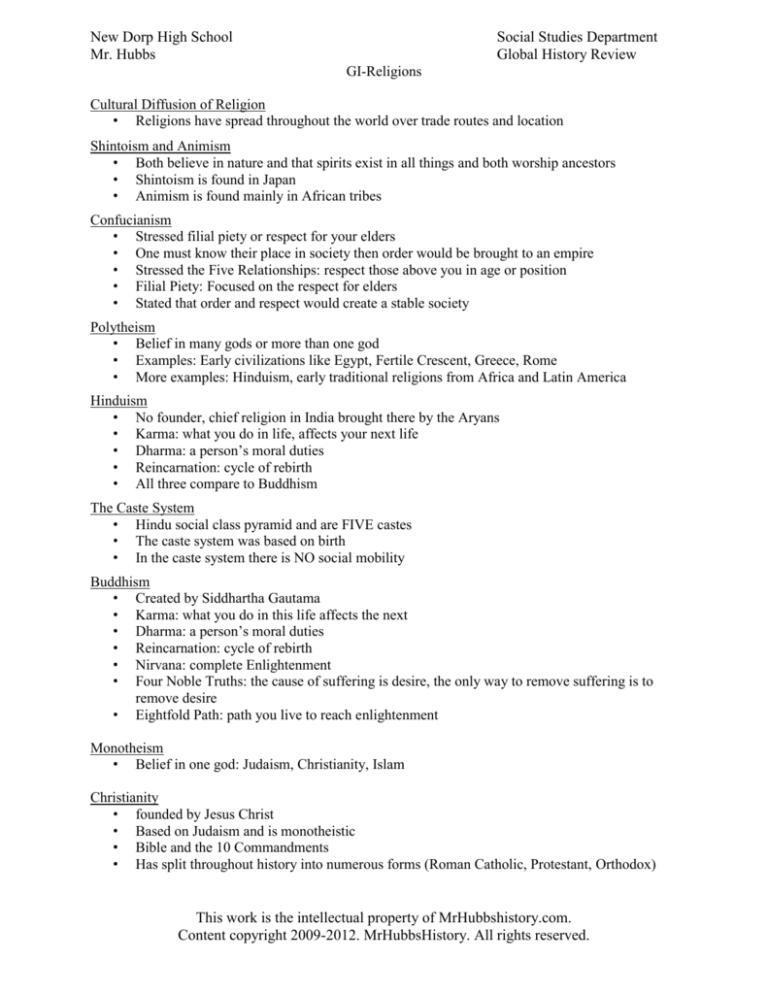
New Dorp High School
Mr. Hubbs
Social Studies Department
Global History Review
GI-Religions
Cultural Diffusion of Religion
• Religions have spread throughout the world over trade routes and location
Shintoism and Animism
• Both believe in nature and that spirits exist in all things and both worship ancestors
• Shintoism is found in Japan
• Animism is found mainly in African tribes
Confucianism
• Stressed filial piety or respect for your elders
• One must know their place in society then order would be brought to an empire
• Stressed the Five Relationships: respect those above you in age or position
• Filial Piety: Focused on the respect for elders
• Stated that order and respect would create a stable society
Polytheism
• Belief in many gods or more than one god
• Examples: Early civilizations like Egypt, Fertile Crescent, Greece, Rome
• More examples: Hinduism, early traditional religions from Africa and Latin America
Hinduism
• No founder, chief religion in India brought there by the Aryans
• Karma: what you do in life, affects your next life
• Dharma: a person’s moral duties
• Reincarnation: cycle of rebirth
• All three compare to Buddhism
The Caste System
• Hindu social class pyramid and are FIVE castes
• The caste system was based on birth
• In the caste system there is NO social mobility
Buddhism
• Created by Siddhartha Gautama
• Karma: what you do in this life affects the next
• Dharma: a person’s moral duties
• Reincarnation: cycle of rebirth
• Nirvana: complete Enlightenment
• Four Noble Truths: the cause of suffering is desire, the only way to remove suffering is to
remove desire
• Eightfold Path: path you live to reach enlightenment
Monotheism
• Belief in one god: Judaism, Christianity, Islam
Christianity
• founded by Jesus Christ
• Based on Judaism and is monotheistic
• Bible and the 10 Commandments
• Has split throughout history into numerous forms (Roman Catholic, Protestant, Orthodox)
This work is the intellectual property of MrHubbshistory.com.
Content copyright 2009-2012. MrHubbsHistory. All rights reserved.
New Dorp High School
Mr. Hubbs
Islam
• Monotheistic founded by Muhammad
• Practiced the Five Pillars of Faith
1. Allah is the one true god 2. Charity
4. Pilgrimage to Mecca called the Hajj
Social Studies Department
Global History Review
3. Fasting during Ramadan
5. Praying FIVE times a day facing Mecca
All religions have rules or codes of behavior
• Christian and Judaism believe in the 10 Commandments
• Islam has the Five Pillars
• Buddhism: Eightfold Path
• Confucianism: Five Relationships
Sample Questions
1. The doctrines of the Roman Catholic, Eastern Orthodox, and Protestant churches are all based on the
(1) concept of reincarnation
(3) teachings of Muhammad
(2) principles of Christianity
(4) leadership of the pope
2. One way in which the Five Relationships, the Ten Commandments, and the Eightfold Path are
similar is that they
(1) promote polytheism
(3) provide codes of behavior
(2) establish gender equality
(4) describe secularism
3. According to Buddhist principles, believers can end personal suffering by
(1) doing good deeds
(3) making pilgrimages to Mecca
(2) eliminating selfish desires
(4) relying on divine help
4. Which belief system is most closely associated with the terms Eightfold Path, Four Noble Truths,
and nirvana?
(1) Buddhism
(3) Judaism
(2) Christianity
(4) Shinto
5. Christianity, Islam, and Judaism are similar in that they all ask their followers to
(1) believe in reincarnation
(3) follow a code of behavior
(2) strive for nirvana
(4) practice polytheism
“Just as a man, having cast off old garments, puts on others, even so does the embodied one, having
cast off old bodies, take on other, new ones.”
6. Which belief or practice is expressed in this quotation?
(1) rigid class structure
(3) monotheism
(2) reincarnation
(4) fasting and prayer
7. Which belief is most closely associated with the teachings of Siddhartha Gautama (Buddha)?
(1) People are born into a specific caste.
(2) Believers must follow the Ten Commandments.
(3) Followers must fast during Ramadan.
(4) People can overcome their desires by following the Eight-Fold Path.
8. Which action is most closely associated with polytheism?
(1) praying in a synagogue
(3) worshipping many gods
(2) accepting the Eightfold Path
(4) reading the Koran
This work is the intellectual property of MrHubbshistory.com.
Content copyright 2009-2012. MrHubbsHistory. All rights reserved.
New Dorp High School
Mr. Hubbs
Social Studies Department
Global History Review
9. The spread of Buddhist ideas and customs to China and Southeast Asia was the result of
(1) the Mandate of Heaven
(3) cultural diffusion
(2) economic dependence
(4) the civil service system
• Buddhism is introduced into Japan around A.D. 1200.
• Islam extends from the Middle East into Spain by A.D. 732.
• Catholic and Protestant missionaries bring Christianity to Africa in the 1800s.
10. Each of these statements reflects the concept of
(1) cultural diffusion
(3) civil disobedience
(2) urbanization
(4) isolationism
11. One similarity between animism and Shinto is that people who follow these belief systems
(1) practice filial piety
(3) are monotheistic
(2) worship spirits in nature
(4) are required to make pilgrimages
12. Which pair of belief systems share a belief that spirits reside in natural objects and forms?
(1) Hinduism and Confucianism
(3) Shintoism and animism
(2) Islam and Judaism
(4) Christianity and Buddhism
• Showing respect for parents
• Maintaining family honor
• Honoring all elders
13. Which term is most closely related to these three actions?
(1) nirvana
(3) filial piety
(2) animism
(4) hadj (hajj)
14. In China, Confucianism emphasized the idea that
(1) equality should exist between all members of society
(2) salvation could be attained by prayer, meditation, and good deeds
(3) individual goals should be placed ahead of the needs of the group
(4) harmony could be achieved by the proper behavior of each member of a family or society
15. The five relationships taught by Confucius encouraged people to
(1) improve their position in life
(3) respect and worship nature
(2) maintain social and political order
(4) serve the needs of religious leaders
16. Which factor most influenced a person’s social position in early Indian societies?
(1) education
(3) geographic location
(2) birth
(4) individual achievement
17. The caste system in India and the feudal system in Europe were similar in that both
(1) provided structure for society
(3) established totalitarian governments
(2) developed concepts of natural rights
(4) promoted peace and prosperity
This work is the intellectual property of MrHubbshistory.com.
Content copyright 2009-2012. MrHubbsHistory. All rights reserved.


